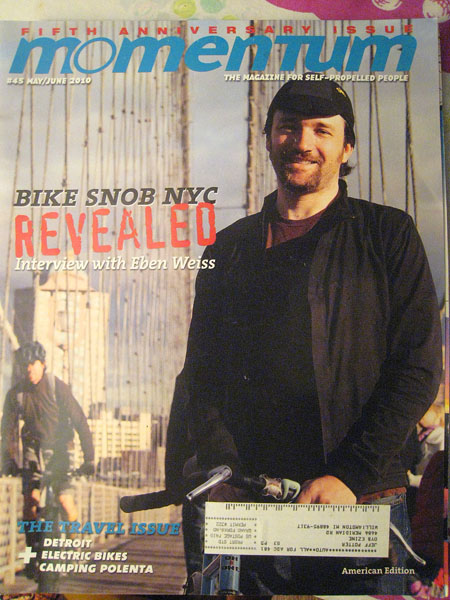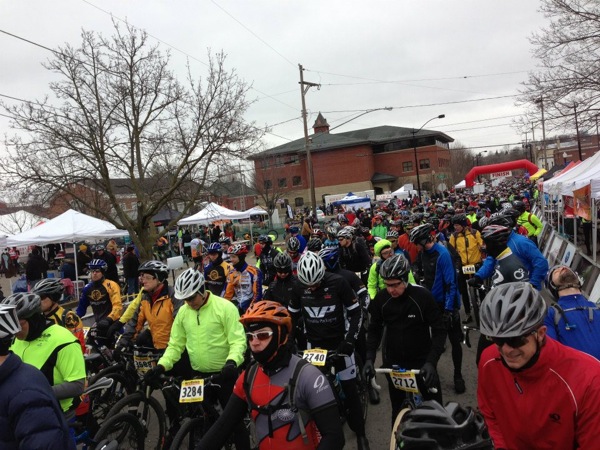Stealing a ride from Old Man Winter
by Eric House
[As background, keep in mind that by now the Sierras above 6000′, where most of this ride takes place, are covered by several feet of snow.]
I watched the weather reports anxiously last week unsure whether we’d get away with it, but we did. And thus one of the most scenic rides I’ve ever done is enhanced, somehow, by the knowledge that we sneaked it in under the wire. By now those roads and trails are under snow that won’t melt before May. But I’m getting ahead of myself….
Saturday before dawn Henry Kingman and I awoke at my parents’ house in Auburn, at 1200′ in the Sierra Nevada foothills, ate a small bowl of oatmeal and headed out on wet roads under threatening clouds and hints of mist. We went east, following frontage roads along Interstate 80 up to Colfax, then hopped on the freeway (illegally,
I believe) to avoid a lengthy detour past Rollins Lake. From Gold Run we alternated between frontage roads and freeway shoulder all the way to Soda Springs, which sits near Donner Pass at about 6500′. Some of the frontage roads were quite pretty, all narrow and covered with fallen leaves and bordered by tin-roofed cabins and second-
growth forests; the freeway was none of this, of course, though there was little traffic thanks to there not yet being snow to hide the scars ski lifts have cut into Sierra mountainsides.
We drew a bit of light rain between Baxter Grade and Blue Canyon, and at one point I suggested we decide how much it’d take to make us turn around. But Henry refused to have that conversation, and we pressed on. At the store in Soda Springs we bought food, and at a ski/mt. bike shop across the street failed to get information about the dirt road we’d soon be taking. Thus we pressed on into we knew not what.
Two miles of pavement lined with vacation homes took us to Serene Lakes, wide and blue at a time when they ought to be frozen over, and to pavement’s end. A sign on a tree there warned Nordic skiers from Royal Gorge Resort not to go further, for now the road (whose surface change would be hidden from them) was to descend into the
American River canyon, from which an unprepared day-skier would be hard pressed to return by nightfall. We began the descent, happy to find that the recent rain had been absorbed by the road leaving a surface that provided excellent support and traction. Soon we’d reached the Cedars, a tiny resort (and abandoned, ‘far as I could tell) at the bottom of the hill.
There is, at the Cedars, a bridge over the North Fork of the American River. Downstream, before its confluence with the Middle Fork below Auburn, there are four more. All of these, however, are clustered within about 15 miles of Auburn; for some 40 miles from the Cedars to the bridge linking Colfax and Iowa Hill there is nothing, the river there being designated “wild and scenic” and protected by the sheer walls of Royal Gorge sometimes 4000′ high.
I had expected to be descending into Royal Gorge, but instead found that we were several miles upstream from the entrance to the canyon, whose mouth we could see across the basin we’d entered. As we rode and studied our map, we realized that we were approaching a river not yet big enough to carve chasms with regal names. Somewhere
nearby, but downstream, tributary streams were coming together to form a powerful river. But we circled this hub, crossing these streams one by one like the spokes of a wheel while they were yet too small to require a bridge. The river itself, here only the largest of many creeks, did earn a bridge, but one that put us only 5′ above water darting among rocks that at the river’s lowest point would probably have allowed us to hop across.
On our traversal of the river’s headwaters we headed mostly south, but once across we turned southwest to climb, parallel to the forming river and eventually to Royal Gorge, onto the upper reaches of the Foresthill Divide, the region bordered by the North and Middle forks of the American River. As we moved leisurely along a road that in most places could be driven in a family sedan, passing through forests of 100′ trees whose north-
facing flanks were covered with moss exactly the color of my PI jacket, we caught glimpses sometimes to the north of the Gorge, and to the south of the peaks and valleys of the Granite Chief Wilderness. The deepest of the basins on either side could have been bottomless for all that we could see.
In summer these mountains provide scenery the equal of anything on earth, but now we were seeing it enhanced. While rainclouds passing quickly overhead sometimes made us fear we’d finish the ride drenched, the dances they did among the peaks and through the passes, and the colors they showed as they filtered sunlight onto the landscape, made granite and pines come alive. I grew up in the foothills of these mountains, and have spent countless hours hiking and skiing and working here, yet never have I seen them the way they were rendered Saturday by those sun-drenched clouds, that wind and the moisture of recent rains.
Twenty-three miles of dirt road passed quickly, and too soon we were at Robinsons Flat, where Foresthill Road becomes paved again. We stopped here to fill our water bottles at a six-foot-tall hand pump in the middle of a meadow — the kind you pump twenty times to get the first gush of water and then keep pumping lest the water column retreat and make you start again. I still have half a bottle left, and am savoring it, it tastes so of altitude and
rain. Now we began the drop to the town of Foresthill — at 3200′ at least 3000′ below us and only 27 miles away — along a road that first dipped and rose much as the dirt part had, yielding glimpses of some of the same basins and canyons. At one point here, hand-lettered black-on-orange-diamond signs warned of logging in progress, and as proof of the claim the corpses of 3′ trees (that’s diameter) sometimes jutted into the road.
After maybe 10 miles, the road fell into line as the top of the Divide, which it followed, became less erratic. There were now only gentle big-ring rollers instead of real descents and climbs, and few curves ahead. Often, the road pointed straight into the setting sun. We reveled in the interplay of the clouds with the sun, and with the way rays of orange light ran through the mist rising off the road and from the trees. Only when we stopped to eat and looked behind us did we realize that we were missing half the show: because the trees along the road were lit from the west,
it was from that direction alone that we could see them reflecting the golden colors of late fall.
It was nearly dark when we reached Foresthill. We stopped there so I could change glasses and call my dad at home to say we’d be late (and to be sure he’d know exactly when we’d be there and ready to eat.) Then, in tight formation since only one of us had a headlight, and with the only heavy traffic of the day, we began the final 2000′ drop to Auburn. And while it was soon dark enough that an oncomming car could blind me to all but the fog stripe just to my right, between strings of cars there was enough ambient light from the waxing moon that we could see the deeper
shadows of the two river canyons as they converged, one on either side, toward where their rivers join (and where the Divide ends.) We crossed the North Fork on the new bridge some 500’ above the riverbed, and maybe 1/2 mile upstream from the confluence, and stopped mid-span to peer into the darkness at what had been a trickle under our wheels just hours before. What a ride!
A note on equipment: I think it should be mentioned that both of us rode 700c Conti 28mm Top Touring tires, smallish “hybrid” tires with an inverted tread. These were more than adequate for the dirt we encountered, yet close enough to road tires to make a 140-mile day possible even at our leisurely pace. To do a ride like this on a mountain bike would have been miserable. In fact, though both of us rode multi-purpose bikes with space for bigger tires, most road bikes will accept this sort of tire, and with an adequate low gear (maybe a 28×26 or so) would be fine on most of
the dirt roads in this part of the Sierra. To my mind it’s much more satisfying to do this sort of loop than to be forced by an over-specialized mountain bike to drive to the end of the road.
–Eric House



